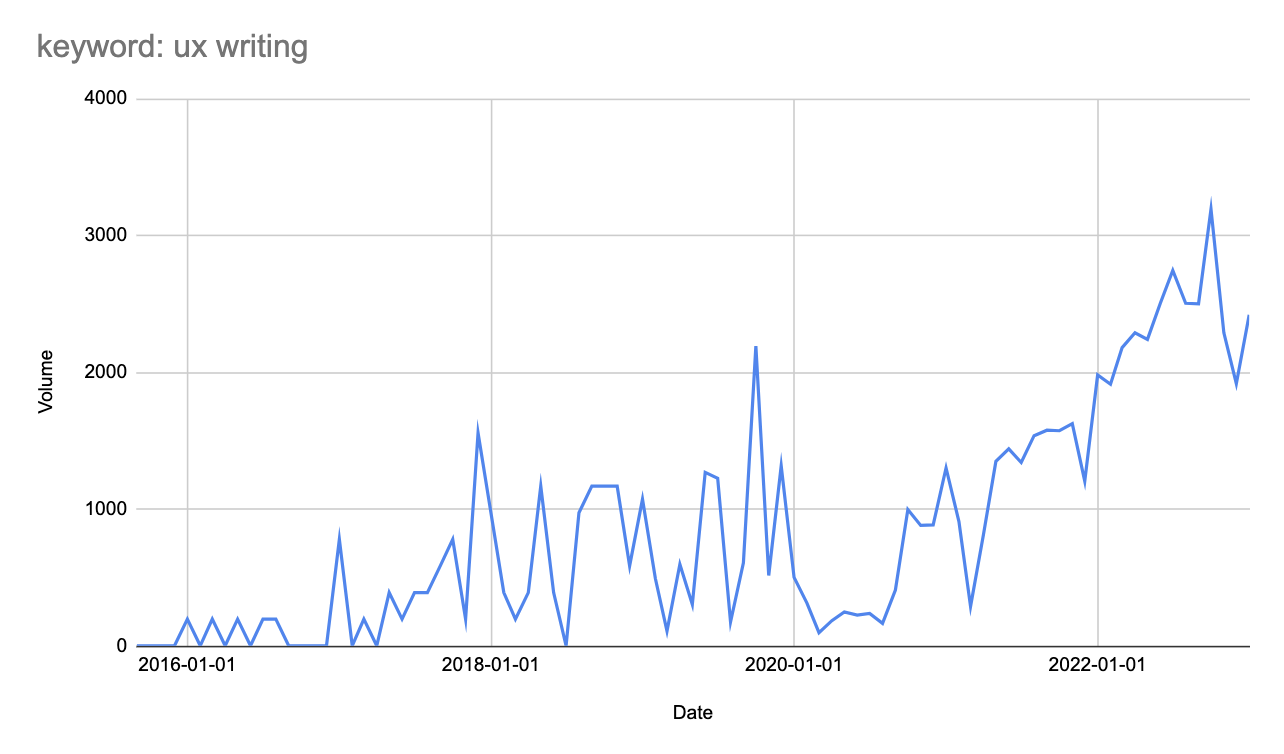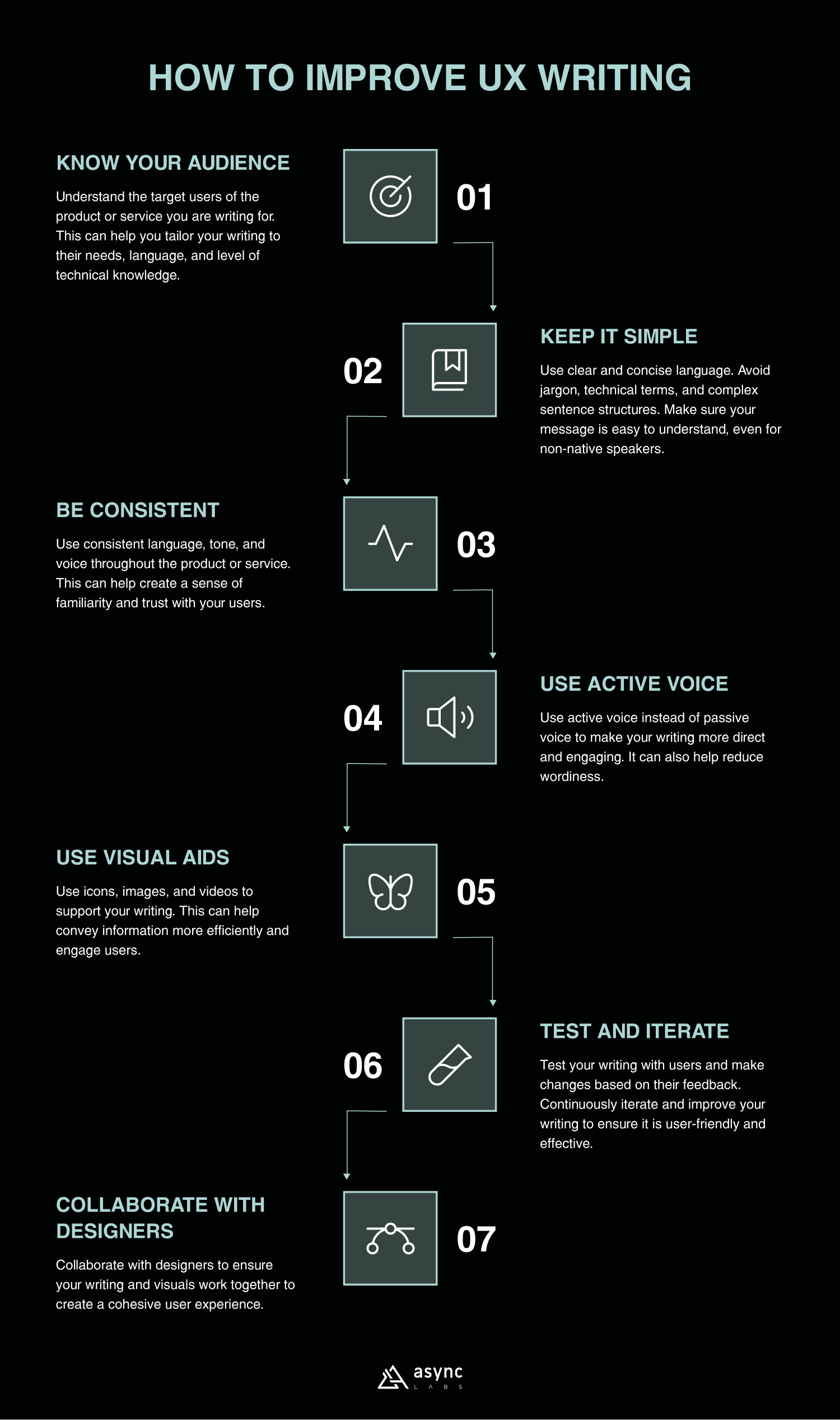Before diving into UX writing skills, first, we have to get an idea of what UX writing is. You probably think it’s all about writing user-friendly content for different platforms and digital problems. But what’s the deal?
In today’s digital world, user experience (UX) has become a crucial element of product design. As such, UX writing has become an essential part of the design process. UX writing involves crafting user-facing content, including copy, microcopy, and other messaging that guides the user through the product experience.
52% of people say a bad mobile experience makes them lose faith in a company. 94% of first impressions are related to your website’s design. 85% of users want a mobile experience as good as a desktop. A bad mobile experience annoys 48% of users. Still wondering what is the value of UX writing?
In this post, we’ll cover five essential UX writing skills every writer should master to create effective and user-friendly digital experiences.
What is UX writing?
UX writing, also known as user experience writing, creates clear, concise, and compelling copy that guides users through digital experiences. It’s a critical aspect of user-centered design that helps users achieve their goals while using a product or service.
Mastering UX writing can make a big difference in the success of a digital product.
“User experience (UX) writing is the practice of crafting the user-facing and user-guiding text that appears within the design of digital products.” (definition by UX Content Collective)
It is different from copywriting and technical writing because these aren’t part of the design process, and they occur either after or before the design team plans the product.
The significance of digital products is continuously growing as they are becoming increasingly vital across all industries. It’s not just about apps and websites. The need for various digital products is ubiquitous.
UX writers are responsible for crafting copy for user interfaces, user flows, error messages, tooltips, and other interactive elements of digital products.
The goal of UX writing is to create a copy that is easy to understand, helpful, and engaging for users while aligning with the product’s overall branding and messaging. UX writing can create positive user experiences and increase user engagement and retention.
For example, the term UX writing has been searched worldwide for various months over the past five years. In 2016, it had approximately 195 searches per month; in 2023, the volume of monthly searches grew to 2420. This indicates a massive increase in interest since 2016, suggesting that people are becoming more aware of and curious about UX writing.

What makes a good UX writer?
Writing, of course, is a huge part of a UX writer’s job, but it’s actually just a tiny part of it. There are many other things that UX writers do. To become a successful UX writer, you need specific skills that make your writing compelling. In this blog post, we will explore what skills you need as a UX writer, what makes a good UX writer, and how to improve UX writing.
A UX writer creates user-focused content that enhances the overall user experience. They understand the user’s perspective and can communicate complex ideas clearly and concisely. They also have a good eye for detail and can ensure consistency across all content, from microcopy to error messages.
A good UX writer has a combination of skills, experience, and personality traits that make them stand out. Some of the essential qualities that make a good UX writer include the following:
- Empathy: A good UX writer understands the user’s needs and emotions and can write copy that resonates with them.
- Attention to detail: UX writing involves crafting error-free, consistent, and precise copy.
- Flexibility: UX writers need to be flexible and open to feedback and change as the design process evolves.
- Problem-solving skills: UX writers need to be able to identify and solve problems that may arise during the design process.
- Creativity: A good UX writer can develop creative solutions to make the user experience more engaging and delightful.
What skills are required for UX writing?
As a UX writer, you need to have excellent writing skills. You must write clear, concise, and engaging copy that conveys the desired message to the user. You should also be familiar with the basics of user experience design and understand how users interact with digital products.
Here are 5 essential UX writing skills:
Language skills
Your primary tool as a UX writer is language. To succeed in this field, you must comprehend how language shapes the human experience and how it can be used to solve usability issues. You should also be able to articulate your thoughts so that others can understand and follow them.
A skilled UX writer can simplify complex information or instructions, making them intuitive and natural to understand. Unlike copywriting, which focuses on grabbing attention, UX writing prioritizes clear communication to facilitate users’ navigation through a digital product. It has to match the user’s expectations of how the product should work.
Before putting pen to paper, extensive research is necessary to comprehend the product and its unique requirements. The quality of your writing is what counts, not the quantity.
UX writing should encourage users to take action. Action-oriented language can help users feel more confident and empowered when using a product. UX writers should use active verbs and clear calls to action (CTAs) to guide users through the product.
A deep understanding of UX
As a UX writer, your role is not limited to crafting only copy; it involves bridging gaps in your information architecture and product logic to ensure a cohesive and streamlined product.
To excel in UX writing, it’s essential to have a designer’s mindset for problem-solving, along with a thorough grasp of user-centered design, design thinking, and product strategy. This requires consistently adopting the user’s perspective and prioritizing the overall quality of the user experience.
Clarity and consistency
When it comes to UX writing, clarity and consistency are key. Users want to quickly understand what a product does, how to use it, and what to expect. Writing clear and concise copy can help users achieve these goals.
UX writers should focus on using simple language, avoiding jargon, and breaking down complex concepts into digestible chunks of information. Additionally, they should aim to reduce the word count as much as possible while maintaining clarity.
UX writers should establish a consistent voice and tone throughout the product. The copy has to be consistent with the product’s branding and messaging. Consistent language and tone can help users feel more comfortable and familiar with a product. It also helps users navigate the product more efficiently.
User empathy
Effective UX writing requires a deep understanding of the target audience. UX writers should put themselves in the user’s shoes and anticipate their needs and questions. They should consider the user’s context, such as their level of expertise and the device they’re using, and write a copy that speaks directly to them.
By empathizing with users, UX writers can create relevant, helpful copy that resonates with the user. Except for users, you should empathize with your team members and stakeholders and be aware of their needs, preferences, limitations, and worries.
Accessibility
Accessibility is a critical aspect of UX writing. UX writers should strive to make the copy as inclusive as possible, considering users with different abilities, languages, and cultural backgrounds. They should avoid jargon, idioms, or cultural references that may be unfamiliar to some users.
Additionally, UX writers should consider using alternative text for images, captions for videos, and other accessibility features to make the copy more accessible to all users.
Another handy skill relevant to working in a UX team is proficiency in design tools, such as Sketch, Figma, InVision, Zeppelin, and JIRA. While you don’t necessarily need to be an expert in these tools, you’ll likely work with them as your colleagues, and the products you write for are created using them.
By mastering these five essential UX writing skills, designers can create effective and user-friendly digital experiences that meet the needs of their target audience.
In addition, you should be able to:
- Understand the user’s perspective: UX writing is about putting yourself in the user’s shoes. You should be able to empathize with the user and understand their needs, goals, and pain points.
- Use simple language: Your writing should be easy to understand, using simple language accessible to all users, regardless of their level of education or language skills.
- Collaborate effectively: UX writing is often a collaborative effort, requiring you to work closely with designers, developers, and other stakeholders. You should be able to communicate your ideas clearly and work well in a team environment.
What are examples of UX writing?
UX writing examples include microcopy, error messages, onboarding instructions, product descriptions, and button labels.
Microcopy refers to small snippets of copy that appear throughout a digital product, such as tooltips, button labels, and confirmation messages. Error messages inform users when something has gone wrong and offer solutions to help them recover.
Onboarding instructions guide users through the setup process and help them understand the product’s features and benefits. Product descriptions provide users with information about the product’s features, benefits, and how it works.
There are many brands known for their exceptional UX writing. All of them have recognized the importance of UX writing in creating a seamless user experience and have invested in creating high-quality UX writing that resonates with their target audience.
Here are a few examples:
Apple
Apple’s UX writing is clear, concise, and consistent across all their products, making it easy for users to understand and navigate their devices intuitively and enjoyably. They use simple language that avoids technical jargon, making their products more accessible to a wider audience.

For example, when you set up a new Apple device, the onboarding process provides clear and concise instructions that guide you through the setup process. Apple also uses microcopy (short text snippets) throughout their products, such as error messages, alerts, and notifications, to provide helpful feedback and guide users through the user interface.
Slack
Slack is a communication platform known for playful yet professional UX writing. They use witty messages to guide users through their platform, making it an enjoyable experience.
Slack’s UX writing has a distinct personality that reflects the brand’s values and culture. They use humor and wit to make users feel like they’re conversing with the app. This personality also extends to their error messages and notifications, which are often amusing and friendly.

Mailchimp
Mailchimp’s UX writing is a key part of what makes the platform so popular and effective for marketing automation. Its UX writing uses a conversational tone that makes users feel like they are conversing with a helpful friend.
Their friendly and approachable tone and clear and concise language make it easy for users to navigate the platform and achieve their marketing goals.

Spotify
Fun and engaging, user-friendly, and focused on helping users discover and enjoy music and making them feel like they’re conversing with the app. They also use personalization to create a unique experience for each user.

Spotify’s UX writing uses language focused on the user and their music preferences. They use personalized recommendations and tailored playlists to create a unique and more enjoyable experience for each user. They also use simple and direct language to help users understand features and options, such as creating playlists or finding new artists.

How to improve UX writing

Improving UX writing can be a continuous process, but here are some tips that can help you get started:
- Know your audience: Understand the target users of the product or service you are writing for. This can help you tailor your writing to their needs, language, and level of technical knowledge.
- Keep it simple: Use clear and concise language. Avoid jargon, technical terms, and complex sentence structures. Make sure your message is easy to understand, even for non-native speakers.
- Be consistent: Use consistent language, tone, and voice throughout the product or service. This can help create a sense of familiarity and trust with your users.
- Use active voice: Use active voice instead of passive voice to make your writing more direct and engaging. It can also help reduce wordiness.
- Use visual aids: Use icons, images, and videos to support your writing. This can help convey information more efficiently and engage users.
- Test and iterate: Test your writing with users and make changes based on their feedback. Continuously iterate and improve your writing to ensure it is user-friendly and effective.
- Collaborate with designers: Collaborate with designers to ensure your writing and visuals work together to create a cohesive user experience.
Boost engagement with a single word
UX writing is a critical component of creating a great user experience that engages and delights your audience. By developing strong UX writing skills, you can effectively communicate with your users, build trust, and help them achieve their goals.
To boost engagement with your audience, consider the following tips:
- Use conversational language and tone to make your writing approachable and relatable.
- Focus on clarity and simplicity to ensure users understand what they need to do.
- Provide helpful guidance and support throughout the user journey.
- Develop a consistent brand voice that reflects your values and personality.
- Continuously test and iterate your UX writing to optimize for user engagement.
By incorporating these strategies into your UX writing, you can create a user experience that is engaging, enjoyable, and effective. Remember, UX writing is a constantly evolving discipline, so continue to refine your skills and stay up-to-date with best practices to ensure that your writing remains effective and impactful.
Don’t let poor UX writing and design hold your site back – partner with us to create an exceptional user experience. Get in touch.
